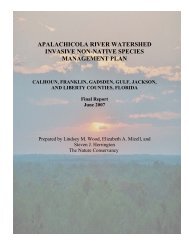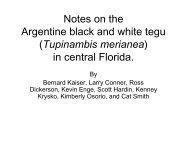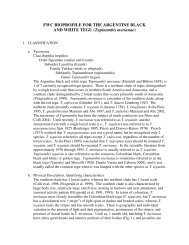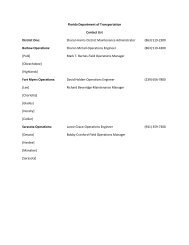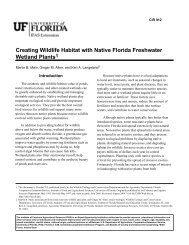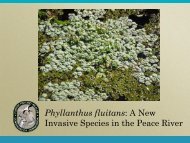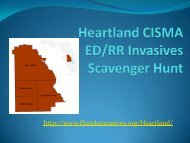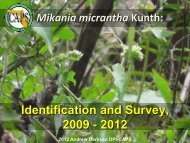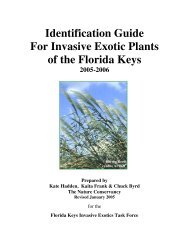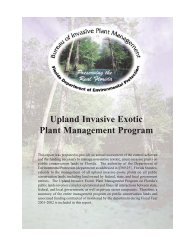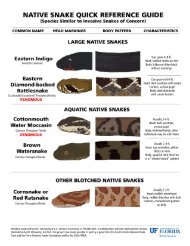florida keys invasive exotics task force - Florida Invasive Species ...
florida keys invasive exotics task force - Florida Invasive Species ...
florida keys invasive exotics task force - Florida Invasive Species ...
You also want an ePaper? Increase the reach of your titles
YUMPU automatically turns print PDFs into web optimized ePapers that Google loves.
FLORIDA KEYS INVASIVE EXOTICS TASK FORCE (FKIETF) LIST OF INVASIVE PLANTS OF THE FLORIDA KEYS - 2005<br />
EPPC = CATEGORY CLASSIFICATION ON EXOTIC PEST PLAN COUNCIL'S 2003 LIST OF FLORIDA'S MOST INVASIVE SPECIES. SEEDING = DISPERSAL METHOD, FRUITING/FLOWERING SEASON IN FL KEYS<br />
SCIENTIFIC NAME COMMON NAME EPPC KEYS INVASION PATTERN AND COMMENTS SEEDING ERADICATION RECOMMENDATION<br />
(DISPERSAL, SEASON)<br />
FKIETF CATEGORY I: INVASIVE EXOTICS THAT ARE ALTERING FLORIDA KEYS NATIVE PLANT COMMUNITIES BY DISPLACING NATIVE SPECIES,<br />
CHANGING COMMUNITY STRUCTURES OR ECOLOGICAL FUNCTIONS, OR HYBRIDIZING WITH NATIVES<br />
Casuarina equisetifolia Australian pine I Highly <strong>invasive</strong> in wetlands and uplands wind blown, year round Basal or stump with 10%-30% Garlon 4<br />
Colubrina asiatica Asiatic colubrina I Highly <strong>invasive</strong>, especially on beaches and coastlines floating, year round Foliar with 3% Garlon 4 in cut grid pattern<br />
Ficus microcarpa Laurel fig I Highly <strong>invasive</strong> in uplands in Upper Keys, epi- and litho-phytic birds Basal with 5% Garlon 4<br />
Leucaena leucocephala Lead tree II <strong>Invasive</strong> mainly on roadways and disturbed edges at present nearly year round Basal or stump with 40% Garlon 4<br />
Manilkara zapota Sapodilla I High localized invasion in higher elevation hammocks heavy fruit, year round Basal with 10%-25% Garlon 4<br />
Melaleuca quinquenervia Melaleuca I Localized invasion in N. Key Largo, Stock I. and Boca Chica wind blown, Aug - Dec Hack and squirt with 50% Garlon 3A and 1% Arsenal<br />
Neyraudia reynaudiana Burma reed I<br />
Scaevola sericea Beach naupaka I<br />
Schefflera actinophylla<br />
I<br />
Prefers disturbed and ruderal sites but moves into undis-turbed<br />
hammocks; occurs on all roadsides in Upper Keys;at least one<br />
fairly large patch treated on Big Pine Key<br />
Spreads quickly from landscaping, especially on beaches and<br />
coastal edges/causeways<br />
Hammock and mangrove margins, disturbed sites and spoil<br />
islands in the Upper Keys<br />
seed/rhizome<br />
tides/birds/animals, nearly<br />
year round<br />
Foliar with 2% Roundup Pro<br />
Basal with 10% Garlon 4 or stump with 50% Garlon 3A<br />
Basal with 10% Garlon 4 or stump with 50% Garlon 3A<br />
Queensland umbrella tree<br />
birds, summer<br />
Schinus terebinthifolius Brazilian pepper I Highly <strong>invasive</strong> in wetlands and uplands animals, Oct - Mar Basal or stump with 10%-15% Garlon 4<br />
Thespesia populnea Seaside mahoe I High localized invasion in transitional areas floating, year round Stump with 50% Garlon 3A applied immediately<br />
FKIETF CATEGORY II: INVASIVE EXOTICS THAT HAVE INCREASED IN ABUNDANCE OR FREQUENCY BUT HAVE NOT YET ALTERED FLORIDA KEYS<br />
PLANT COMMUNITIES TO THE EXTENT SHOWN BYCATEGORY I SPECIES (CONTINUED)<br />
Acacia auriculiformis Earleaf acacia I Local problem in Upper Keys; has appeared in Lower Keys wind blown Stump with 50% Garlon 3A<br />
Agave sisalana Sisal hemp II Spreads from landscapes and establishes where dumped tall seed stalks, Jun-Aug Spray with 3% Garlon 4 on center bud<br />
Albizia lebbeck Woman's tongue I Problem in Upper Keys, occurs throughout Keys wind blown Basal or stump with 30% Garlon 4<br />
Asparagus densiflorus Asparagus fern I Spreads from landscapes and establishes where dumped dumping/birds/animals Foliar with 2% Roundup Pro<br />
Asystasia gangetica Ganges primrose II Spreads from disturbed sites and climbs forest edges Mar - Aug Foliar with 2% Roundup Pro<br />
Casuarina cunninghamiana Australian pine II Suckering, somewhat cold tolerant, very limited in Keys wind blown, year round Basal or stump with 10%-30% Garlon 4<br />
Casuarina glauca Australian pine I<br />
no seeds - suckers off<br />
Less salt tolerant and less widespread than C. equisetifolia planted trees<br />
Basal or stump with 10%-30% Garlon 4<br />
Cryptostegia madagascariensis Madagascar rubber vine II<br />
Occurs in transitional wetlands, old homesteads in Upper Keys<br />
summer, wind blown Basal with 10% Garlon 4<br />
Cupaniopsis anacardioides Carrotwood I<br />
Recent introduction; has spread from planting in Key West;<br />
invades uplands to buttonwood zone<br />
birds/small mammals Basal with 10% Garlon 4 or stump with 50% Garlon 3A<br />
Dichrostachys cinera Sickle bush, Marabu II Dense thickets in Cuba, Pacific Islands. mowing, rhizomes Unknown at this time.<br />
Dioscorea bulbifera Air Potato I Invades variety of habitats: 23 FL counties, Big Pine & Cudjoe vine, tubers, floats Manual removal<br />
Epipremnum pinnatum Pothos (philodendron) II Has spread from landscapes, dump sites to hammock Foliar with 2% Roundup Pro<br />
Furcraea cabuya Central American sisal n/a Spreads from landscapes and dump sites; localized Jun - Aug Spray with 3% Garlon 4 on center bud<br />
Hibiscus tiliaceus Sea hibiscus II So far largely limited to disturbed sites drift seed/wrack lines Stump with 50% Garlon 3A applied immediately<br />
Hylocereus undatus Night-blooming cereus n/a Spreads from landscapes and dump sites; localized animals, suckering Manual removal<br />
Kalenchoe spp. Life plant II Spreads from landscapes and dump sites; localized Foliar with 2% Roundup Pro<br />
Lantana camara Lantana I Spreads from landscapes to hammock/pineland margins bird dispersed, yr round Basal with 5% Garlon 4<br />
Nephrolepis multiflora Asian sword fern I Invades hammocks seeds spores/rhizome Foliar with 2% Roundup Pro<br />
Panicum maximum Guinea grass II Present in Keys, but extent of invasion unknown rhizomes/seeds Foliar with 2% Roundup Pro<br />
Panicum repens Torpedograss I Present in Keys, but extent of invasion unknown rhizomes/seeds Foliar with high concentration of Rodeo<br />
Pennisetum purpureum Napier grass I So far limited to roadsides mowing, yr round Foliar with 2% Roundup Pro<br />
Pennisetum setacea Fountain grass II Planted for landscaping and is currently spreading on roadsides, mowing, medians yr and round disturbed sites; Foliar seeds with after 2% mowing Roundup Pro<br />
Psidium spp. Guava I Spreads from neighborhood fruit trees into uplands mammals/humans Basal with 10% Garlon 4<br />
Rhoeo spathacea Oyster plant I Spreads from landscaping and establishes where dumped Foliar with 3% Garlon 4 in water or oil<br />
Sansevieria hyacinthoides Bowstring hemp II Spreads from landscaping and establishes where dumped seeds/rhizomes Foliar with 5% Garlon 4 in water or oil<br />
Stachytarpheta urticifolia Porterweed n/a Non Native porter weed that hybridizes with native<br />
Tecoma stans Yellow elder n/a moving into hammocks from disturbed edges<br />
Terminalia catappa Tropical almond II occasional problem on Keys coastlines and near plantings drift seed Basal with 10% Garlon 4 or stump with 50% Garlon 3A<br />
Tribulus cistoides Puncture weed II Moving down the roadside; also on beaches animals, year round Foliar with 2% Roundup Pro<br />
Wedelia trilobata Wedelia II disturbed sites, beaches year round Foliar with 2% Roundup Pro
FLORIDA KEYS INVASIVE EXOTICS TASK FORCE (FKIETF) LIST OF INVASIVE PLANTS OF THE FLORIDA KEYS - 2005<br />
EPPC = CATEGORY CLASSIFICATION ON EXOTIC PEST PLAN COUNCIL'S 2003 LIST OF FLORIDA'S MOST INVASIVE SPECIES. SEEDING = DISPERSAL METHOD, FRUITING/FLOWERING SEASON IN FL KEYS<br />
SCIENTIFIC NAME COMMON NAME EPPC KEYS INVASION PATTERN AND COMMENTS SEEDING ERADICATION RECOMMENDATION<br />
(DISPERSAL, SEASON)<br />
FKIETF CATEGORY III: INVASIVE EXOTICS THAT HAVE NOT YET BECOME A SERIOUS PROBLEM IN THE FLORIDA KEYS BUT ARE TO BE WATCHED (TBW).<br />
Adenanthera pavonina Red sandlewood II Fast growing and spreading where planted wind blown<br />
Ardisia elliptica Shoebutton ardisia I Moving south on Card Sound Road; not yet over bridge birds, year round<br />
Bauhinia variegata Orchid tree I Planted here but no escape observed yet<br />
Broussonetia papyrifera Paper mulberry II One escape in Key Largo, serious problem in Dade<br />
Bucida bucera Black Olive n/a Copius seeder, may invade canopy gaps near parent<br />
Bucida bucera B. spinosa Black Olive n/a Has been found in Key Largo Hammocks<br />
Carica papaya Papaya n/a Found in hammocks and along coastal berms<br />
Catharanthus roseus Madagascar periwinkle n/a disturbed sites, beaches<br />
Clusia rosea Pitch apple/autograph tree n/a spreading in Key Largo/Dade/Broward, epiphytic, lithophytic birds, spring-summer Basal with 10% Garlon 4<br />
Dactyloctenium aegyptium Crowfoot grass n/a<br />
So far seems to be limited to disturbed sites or as an<br />
earlycolonizer only at natural sites<br />
Ficus altissima False banyan II Planted here but no escape observed yet birds<br />
Flacourtia indica Governor's plum II Planted here but no escape observed yet animals<br />
Jacquinia arbora Bracelet Wood n/a disturbed sites, Key Largo Geiger Key areas<br />
Macroptilium artopurpureum Jumbie bean n/a edge spieces, moving into coastal berms and dunes Wind blown<br />
Macroptilium lathyroides Jumbie bean n/a edge spieces, moving into coastal berms and dunes Wind blown<br />
Melia azedarach Chinaberry I Planted as ornamental and has potential to spread animals<br />
Merremia tuberosa Wood rose II It's planted in Keys; is a problem in Dade year round<br />
Murraya paniculata Orange-jessamine II Planted here but no escape observed yet animals<br />
Ochrosia parviflora Kopsia n/a Planted here but no escape observed yet<br />
Oeceoclades maculata Ground orchid n/a<br />
Definitely invades, but does it disrupt? There's some question<br />
as to whether it's introduced or naturally arrived<br />
Phoenix spp. Date palm II<br />
Localized problem at Marquesas Keys and Cape <strong>Florida</strong> EPPC<br />
lists P. reclinata as Cat. II<br />
rhizomes/seeds<br />
Manual removal<br />
Rhynchelytrum repens Natal grass II Occurs roadside over the entire Keys; potential problem year round Foliar with 2% Roundup Pro<br />
Solanum viarum Tropical soda apple I Invades pastures and upland pines livestock/mamals/ hay Glyphosate at a 3% solution<br />
Stenotaphrum secundatum St. Augustine grass n/a Planted, beginning to invade hammocks from roadsides. rhizomes, Sep-Nov<br />
Syzygium cumini Java Plum I One site on Ramrod key, waiting to see birds/small mammals Glyphosate at a 3% solution<br />
Tabebuia sp. Pink shower tree n/a One localized problem known at Upper Sugarloaf Key wind blown, Mar - Aug<br />
Tamarindus indicus Tamarind n/a Naturalizing in Key Largo hammock<br />
Tradescantia spp. Wandering Jew I<br />
Spreads from landscapes and dump sites; Spreading along<br />
some forest edges in the Upper Keys; localized<br />
Spreading along some forest edges in the Upper Keys<br />
Turnera ulmifolia Yellow alder ? Disturbed areas may invade beach dunes<br />
Vitex trifolia Chastetree ? Key Largo Hammocks & Long Key as a landscape tree Landscapers<br />
Zoysia japonica Zoysia grass n/a Escaping from park residence at N end of Bahia Honda rhizomes Foliar with 2% Roundup Pro<br />
Plants that may Hybridize with natives or are being sold as natives<br />
Exotic - Scientific Name Exotic - Common Name hybridize?Native - Scientific name Native - Common Name Distinctive differences<br />
Hamelia patens var. glabra African Fire Bush ? Hamelia patens var. patens Fire Bush Exotic has some yellow flowers and mostly smooth leaves.<br />
Lantana camara Lantana/Shrub Verbena Y Lantana involucrata Lantana / Wild Sage Native flowers are white and small, <strong>exotics</strong> are multicolored.<br />
Scaevola sericea & S. taccada Beach Napauka ? Scaevola plumieri Ink berry Natives are darker green, have white seeds and aren't fuzzy.<br />
Stachytarpheta urticifola<br />
Porterweed/ Nettleleaf<br />
Y Stachytarpheta jamaicensis Blue Porterweed<br />
Native is short (



